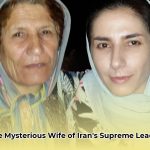Mansoureh Khojasteh Bagherzadeh, the wife of Iran’s Supreme Leader Ali Khamenei, is a figure largely absent from the public eye. This absence, combined with limited verifiable information, creates an aura of mystery that piques widespread curiosity. For a more detailed biography, see this resource. This article seeks to explore her background, family life, and potential impact within Iranian society, piecing together a narrative from available sources while acknowledging the significant gaps in our understanding.
The Enigma of Mansoureh Khojasteh Bagherzadeh
Mansoureh Khojasteh Bagherzadeh’s story is less a well-documented biography and more a collection of fragments, offering glimpses into Iranian politics and societal norms. Her private life and the limited public information available require a careful examination of existing data.
A Life Lived in the Shadows
Mansoureh Khojasteh Bagherzadeh’s limited public appearances naturally lead to speculation. While such privacy isn’t uncommon for women in similar positions within Iranian society, it adds to the intrigue surrounding her, given her husband’s powerful role.
Known Details: Fragments of a Private World
Reliable information about Mansoureh Khojasteh Bagherzadeh indicates that she was born into a religious family in Mashhad. Her father, Mohammad Esmaeil Khojasteh Bagherzadeh, was a businessman. She married Ali Khamenei in the mid-1960s. Accounts also suggest her involvement in charitable activities. However, comprehensive details remain elusive.
Unraveling the Mysteries: The Gaps in Our Knowledge
Significant uncertainties surround many aspects of Mansoureh Khojasteh Bagherzadeh’s life. Basic biographical details contain inconsistencies. Her birth year is debated, with sources suggesting dates ranging from 1945 to 1947. Information about her education and activities before her marriage to Ali Khamenei is scarce.
Understanding the Context: Iranian Culture and Politics
Iranian culture and politics are essential to understanding Mansoureh Khojasteh Bagherzadeh’s life. Traditional gender roles and expectations for women in influential families shape perceptions of her story. Her absence from public life does not necessarily indicate a lack of influence. Discretion is often valued in Iranian culture, especially for women in prominent positions.
The Challenges of Research: Conflicting Accounts and Limited Sources
Researching Mansoureh Khojasteh Bagherzadeh’s life presents considerable challenges. Reliable sources are limited, and available information often conflicts. Many accounts lack thorough fact-checking. Therefore, a skeptical and critical approach is crucial.
Uncertainties: A Summary of Information Gaps
| Information Point | Reported Information | Challenges and Uncertainties |
|---|---|---|
| Birth Year | Sources cite years between 1945 and 1947. | Lack of official records; conflicting reports. |
| Birthplace | Mashhad. | Absence of verifiable documentation. |
| Number of Children | Six children. | Discrepancies across various sources. |
| Education and Profession | Little information exists. | Limited verifiable information exists. |
The Continuing Search for Answers
Mansoureh Khojasteh Bagherzadeh’s story remains incomplete. The private nature of her life, combined with the difficulties of conducting research within Iranian political circles, necessitates an ongoing search for more accurate data.
Verifying Information about Mansoureh Khojasteh Bagherzadeh
Key Takeaways:
- Mansoureh Khojasteh Bagherzadeh’s life is largely private.
- Verifying information about her requires careful analysis of limited and often conflicting sources.
- Iranian cultural and political contexts impact access to biographical details.
An Elusive Figure
Mansoureh Khojasteh Bagherzadeh’s life presents a challenge for those seeking accurate biographical details. Successfully navigating the information requires distinguishing between confirmed facts and speculation, cross-referencing data, and recognizing cultural nuances.
Navigating the Information
Available information reveals some details. She married Ali Khamenei in the mid-1960s and was born in Mashhad. Her father was a businessman, and she comes from a religious family. Further details, such as her exact birthdate and height, are difficult to confirm.
Verification Challenges
Iran’s political climate hinders verification efforts. Information about the Supreme Leader’s family is strictly controlled. The lack of public appearances and verifiable photographs complicates matters.
Strategies for Verification
Verifying information about Mansoureh Khojasteh Bagherzadeh requires rigorously evaluating sources. Distinguishing between confirmed facts and speculation is crucial, and any information should be cross-referenced. Examining the cultural context and acknowledging the emphasis on privacy in Iranian society is also essential.
Limits of Public Knowledge
The enigma of Mansoureh Khojasteh Bagherzadeh highlights the limits of public knowledge regarding powerful political figures in opaque environments. While some aspects of her life can be pieced together, persistent ambiguities highlight the need for cautious interpretation.
Charitable Activities and Social Impact
Key Takeaways:
- Limited public information makes understanding Mansoureh Khojasteh Bagherzadeh’s life challenging.
- Her influence stems from her marriage to Iran’s Supreme Leader and her family’s prominence.
- She maintains a low public profile, yet her actions likely impact Iranian society.
Silence and Influence
Mansoureh Khojasteh Bagherzadeh’s life is private. As the wife of Iran’s Supreme Leader, Ali Khamenei, she possesses influence. Details about her personal life remain scarce, raising questions about the reasons for such obscurity and how it shapes our understanding of her influence.
The Weight of Privacy
The limited number of photos and public statements amplify the mystery. This absence fuels speculation about whether it stems from strategic calculation or cultural norms.
Family and Faith
Her religious upbringing and marriage to Ali Khamenei in the mid-1960s are known. Their children hold roles in Iranian political and religious life, undoubtedly contributing to her sway.
Charitable Activities
While her direct political involvement remains unclear, some accounts suggest charitable activities. However, verification is difficult, as publicly available sources do not document the scale and specifics of her philanthropy.
Navigating the Unknown
Analyzing Mansoureh Khojasteh Bagherzadeh’s role requires understanding the Iranian cultural context, including the importance of family, religious beliefs, and power dynamics within the political system.
Further investigation is needed to achieve a fuller understanding of Mansoureh Khojasteh Bagherzadeh.
Family Background and Influence
Key Takeaways:
- Exploring Mansoureh Khojasteh Bagherzadeh’s family provides valuable context.
- Her upbringing in a religious family shaped her values and worldview.
- Her family connections have likely influenced her role and status.
Religious Upbringing
Mansoureh Khojasteh Bagherzadeh was born into a religious family in Mashhad, a city known for its religious significance in Iran.
Family Connections
Her father, Mohammad Esmaeil Khojasteh Bagherzadeh, was a businessman. Her brother, Hassan Khojasteh Bagherzadeh, held a position as the deputy director of IRIB. These connections have likely influenced her standing within Iranian society.
Marriage to Ali Khamenei
Her marriage to Ali Khamenei in the mid-1960s solidified her position as a prominent figure.
Limited Public Role
Despite her influential connections, Mansoureh Khojasteh Bagherzadeh has maintained a low public profile.
Further Research Needed.
More research is needed to fully understand the impact of her family background and connections on her life.
- Uncover Verna Garver family background: A revealing biography - July 20, 2025
- Uncover the Verna Garver Timeline: A Life Beyond Hollywood - July 20, 2025
- Uncover Verna Garver’s Untold Story: A Life Beyond Headlines - July 20, 2025
















